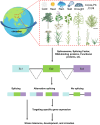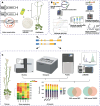Importance of pre-mRNA splicing and its study tools in plants
- PMID: 39883322
- PMCID: PMC11740881
- DOI: 10.1007/s44307-024-00009-9
Importance of pre-mRNA splicing and its study tools in plants
Abstract
Alternative splicing (AS) significantly enriches the diversity of transcriptomes and proteomes, playing a pivotal role in the physiology and development of eukaryotic organisms. With the continuous advancement of high-throughput sequencing technologies, an increasing number of novel transcript isoforms, along with factors related to splicing and their associated functions, are being unveiled. In this review, we succinctly summarize and compare the different splicing mechanisms across prokaryotes and eukaryotes. Furthermore, we provide an extensive overview of the recent progress in various studies on AS covering different developmental stages in diverse plant species and in response to various abiotic stresses. Additionally, we discuss modern techniques for studying the functions and quantification of AS transcripts, as well as their protein products. By integrating genetic studies, quantitative methods, and high-throughput omics techniques, we can discover novel transcript isoforms and functional splicing factors, thereby enhancing our understanding of the roles of various splicing modes in different plant species.
Keywords: Alternative splicing; Modern biotechnology; Plant development; Splicing machinery; Stress response.
© 2024. The Author(s).
Conflict of interest statement
Declarations. Ethics approval and consent to participate: Not applicable. Consent for publication: Not applicable. Competing interests: The authors have no competing interests to declare that are relevant to the content of this article.
Figures


Similar articles
-
Decoding co-/post-transcriptional complexities of plant transcriptomes and epitranscriptome using next-generation sequencing technologies.Biochem Soc Trans. 2020 Dec 18;48(6):2399-2414. doi: 10.1042/BST20190492. Biochem Soc Trans. 2020. PMID: 33196096 Review.
-
Alternative splicing and its regulatory role in woody plants.Tree Physiol. 2020 Oct 29;40(11):1475-1486. doi: 10.1093/treephys/tpaa076. Tree Physiol. 2020. PMID: 32589747 Review.
-
Alternative splicing in plant abiotic stress responses.Biochem Soc Trans. 2020 Oct 30;48(5):2117-2126. doi: 10.1042/BST20200281. Biochem Soc Trans. 2020. PMID: 32869832 Review.
-
Enhancement of Plant Productivity in the Post-Genomics Era.Curr Genomics. 2016 Aug;17(4):295-6. doi: 10.2174/138920291704160607182507. Curr Genomics. 2016. PMID: 27499678 Free PMC article.
-
Alternative splicing as a key player in the fine-tuning of the immunity response in Arabidopsis.Mol Plant Pathol. 2022 Aug;23(8):1226-1238. doi: 10.1111/mpp.13228. Epub 2022 May 14. Mol Plant Pathol. 2022. PMID: 35567423 Free PMC article. Review.
Cited by
-
Adaptation of High-Altitude Plants to Plateau Abiotic Stresses: A Case Study of the Qinghai-Tibet Plateau.Int J Mol Sci. 2025 Mar 4;26(5):2292. doi: 10.3390/ijms26052292. Int J Mol Sci. 2025. PMID: 40076909 Free PMC article. Review.
-
Plant-Fungi Mutualism, Alternative Splicing, and Defense Responses: Balancing Symbiosis and Immunity.Int J Mol Sci. 2025 May 28;26(11):5197. doi: 10.3390/ijms26115197. Int J Mol Sci. 2025. PMID: 40508007 Free PMC article. Review.
-
Targeted deaminase-free T-to-G and C-to-K base editing in rice by fused human uracil DNA glycosylase variants.Plant Biotechnol J. 2025 Apr;23(4):1257-1259. doi: 10.1111/pbi.14583. Epub 2025 Jan 16. Plant Biotechnol J. 2025. PMID: 39817669 Free PMC article. No abstract available.
-
A Comprehensive Analysis of the Alternative Splicing Co-Factor U2AF65B Gene Family Reveals Its Role in Stress Responses and Root Development.Int J Mol Sci. 2025 Apr 20;26(8):3901. doi: 10.3390/ijms26083901. Int J Mol Sci. 2025. PMID: 40332802 Free PMC article.
-
Unraveling the Intricacies of Powdery Mildew: Insights into Colonization, Plant Defense Mechanisms, and Future Strategies.Int J Mol Sci. 2025 Apr 9;26(8):3513. doi: 10.3390/ijms26083513. Int J Mol Sci. 2025. PMID: 40331988 Free PMC article. Review.
References
-
- Arefian M, Antil N, Najar MA, Behera SK, Subba P, Prasad TSK. Identifying novel genes and proteins involved in salt stress perception and signaling of rice seedlings. OMICS. 2022;26(3):151–64. - PubMed
-
- Bao YJ, Chen JX, Zhang YJ, Fernie AR, Zhang J, Huang BX, Zhu FY, Cao FL. Emerging role of jasmonic acid in woody plant development. Advanced Agrochem. 2023; ISSN 2773-2371.
Publication types
Grants and funding
LinkOut - more resources
Full Text Sources
Research Materials
